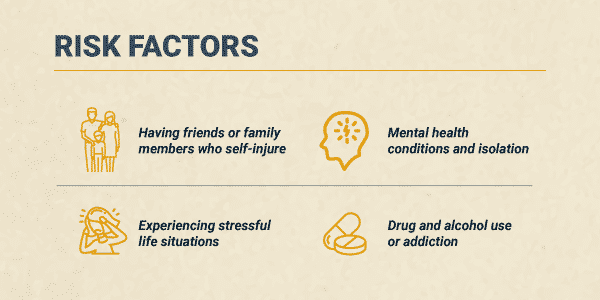Self-harm Myths: What It Isn’t
It is common for negative stereotypes about people who self-harm to be propagated through myths about self-harm. Imperatively you need to be aware of Self-harm Myths and risk Factors. Healthcare professionals have a duty to challenge these negative stereotypes and address them with scientific facts if they are to succeed.
People who self-harm often believe the following myths:
A person who self-harms is seeking attention
This is perhaps the most common stereotype you’ll hear, but it’s not true. It is common for self-harmers to hide their experiences for a long time before they seek help. Self-harmers often have difficulty asking for help because it is so difficult to reach out.
Self-harm is primarily committed by teenage girls
Self-harm is more likely to occur in women and girls, but it can happen to anyone regardless of their gender, age, or background.
A sadist is someone who self-harms for the enjoyment of it / People who self-harm for the enjoyment of it
The perception of pain by people who self-harm is not different from that of the general public. There can be significant consequences to self-harm, including severe pain and physical damage. People who self-harm may consider this pain to be punishment, while others may view it as an attempt to feel strong emotions when they are normally numb.
Self-harmers are suicidal
Attempts at suicide or suicidal thoughts are not exclusively associated with self-harm. When we experience distressing emotions or circumstances, we often turn to this form of coping. It is imperative to note, however, that people who self-harm may feel depressed and may attempt to end their own lives. Taking suicidal thoughts or intent seriously should always be taken into consideration when someone who self-harm communicates with them.
Risk factors for self-harm
Several risk factors may increase the likelihood of someone self-harming. There are minority groups and social groups more at risk for self-harm than others based on adverse experiences and social circumstances, regardless of gender, age, and background.

In the following countries, self-harm rates are higher:
-
Although men and boys commit suicide at higher rates, women and girls also commit suicide.
-
Inmates
-
Seekers of asylum
-
Veterans and members of the armed forces
-
Those who have lost a loved one to suicide
-
Minority groups from some cultures
-
Individuals who belong to a sexual minority
-
Those living in urban areas that are underserved
-
Addicts suffer from substance abuse
-
Those suffering from anxiety or depression are most likely to engage in self-harm. However, adults without depression and anxiety are also affected.
-
As a child, someone who has been physically abused, emotionally abused or sexually abused
Triggers of self-harm
A person’s specific circumstances, experiences, and context are likely to trigger them to self-harm. If you listen carefully to a person’s triggers for self-harm, you may be able to support them in a more targeted manner to address these triggers. The Scottish Executive’s Choose Life suicide prevention strategy (2002, Scottish Executive) cites several common triggers for self-harm, including:
-
Traumatic events, such as abuse or bullying, can lead to trauma
-
Conflict within the family
-
Splitting up with your parents
-
The loneliness of living alone
-
Breakups in relationships
-
Isolation from social networks
-
Suffering from homelessness
-
Loss of employment or an inability to find a new job
-
Illness of the mind/psychiatric disorders
-
Having financial difficulties
-
Problems in the legal system
-
A discriminatory practice
What are the reasons people self-harm?
People who self-harm have many reasons for doing so. There are many reasons why someone might self-harm, and their reasons might change over time. The following reasons may motivate people to self-harm:
-
Managing emotions like anger and sadness when they are difficult and distressing
-
They tend to feel guilty about the wrongdoings they believe they have committed
-
Someone else should be informed of how they feel
-
Emotionally express negative feelings
-
Get away from feelings or emotions by distracting themselves
-
Take steps to address the feelings of numbness that can accompany mental health issues such as depression.